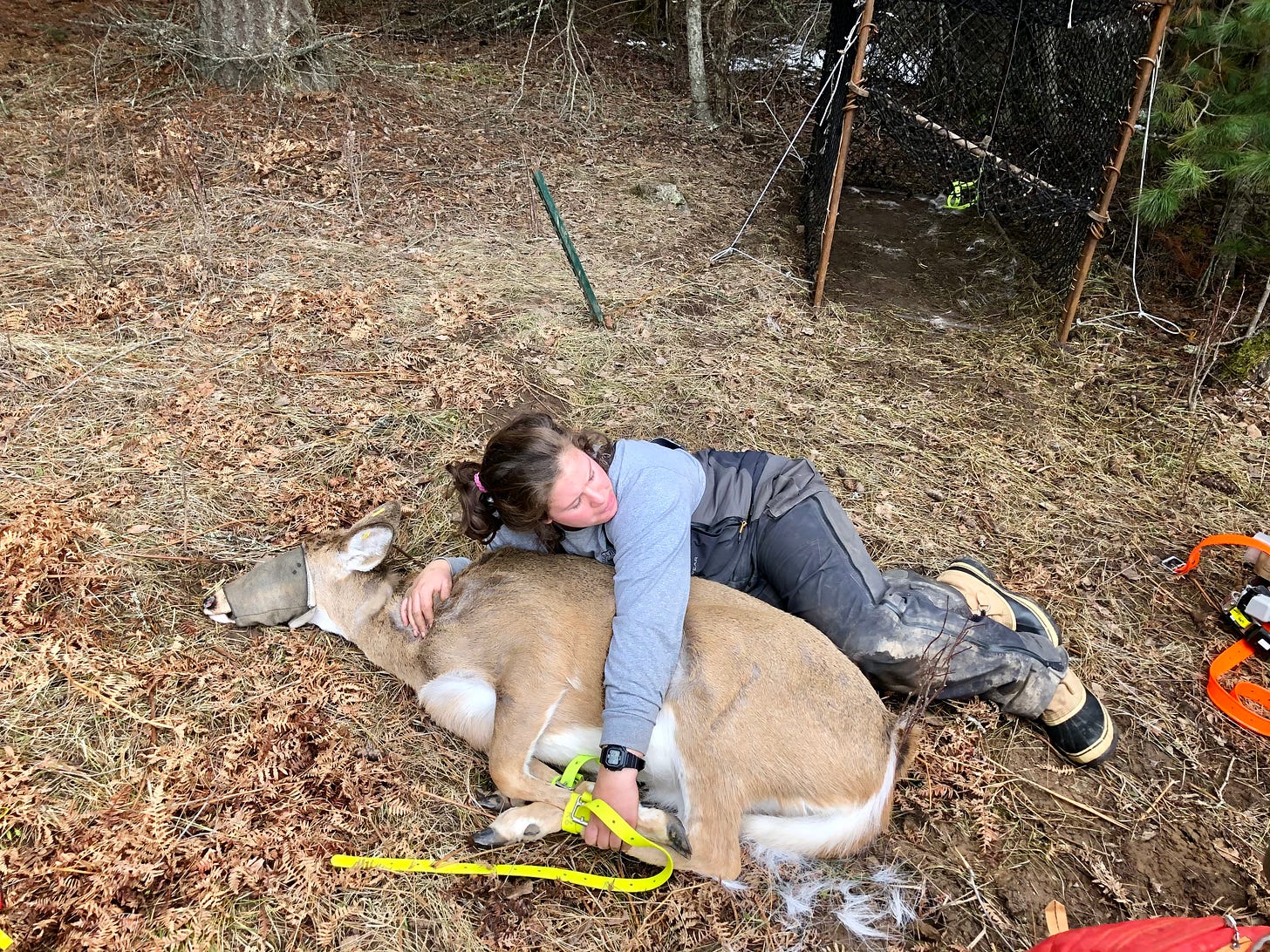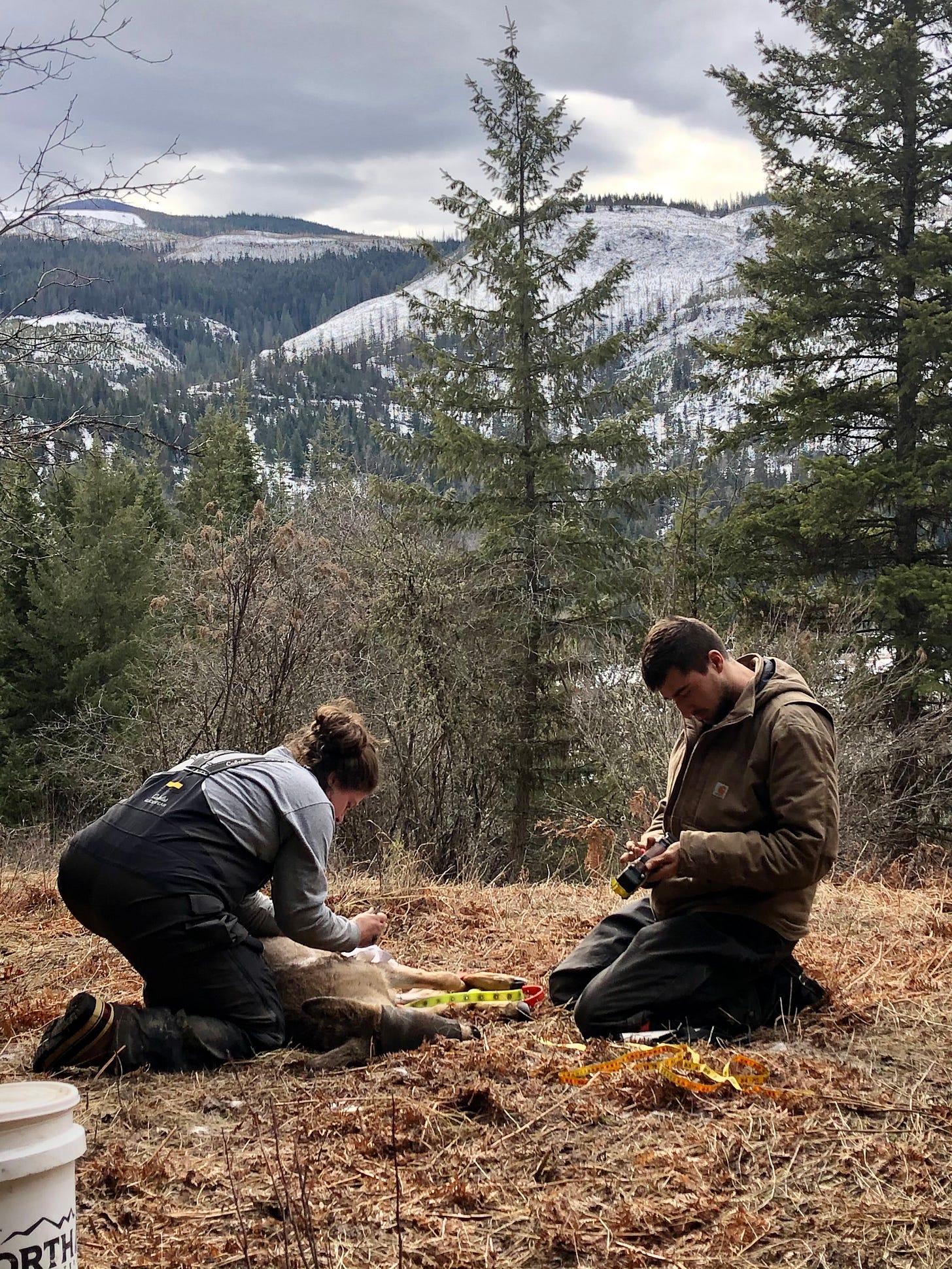The Deer Gyno Will See You Now
Dr. Elizabeth Painter studies whitetails, and it begins in utero.
This article originally appeared as a feature in the Spring Issue of our newsprint magazine eponymously titled The Westrn. Get a print copy shipped from The Westrn Store for just $15.

Author: Kathleen Shannon
Summer 2025 Print Issue (Vol II)
On an icy cold February morning, 90s R&B blasts from the speakers of Elizabeth Painter’s heavy-duty Idaho Fish and Game truck, Big Boy. A French braid falls apart along her head and a half-eaten Kodiak brownie breakfast bowl grows cold in the cupholder. She lifts four fingers off the wheel to wave at a truck passing on the rural road. She doesn’t get one back.
“We’re changing hearts and minds,” Painter says, shrugging. “It’s the long game.”
It’s 2022 and I’m in grad school studying environmental journalism at the University of Montana, where Painter is a doctoral candidate in the wildlife biology department. It’s her third field season researching white-tailed deer survival rates in northern Idaho. She’s letting me tag along for a few days, so I can document her work while bettering my own.
Whitetails are considered the raccoon of deer, for their ubiquity. But that doesn’t mean they should be taken for granted. They make up “a lot of biomass in the system,” Painter told me. Despite being important prey for grizzly and black bears, wolves, cougars, bobcats and coyotes, the state hasn’t tallied white-tailed deer populations much beyond hunting data. Painter remedies that by tracking the predation and survival rates of does and their fawns, starting while fawns are still in utero.
“I’m basically a deer gynecologist,” she says with a smirk. Depending on their age and whether they’re pregnant, she fits deer with collars or other devices. It all requires trapping them first.
Off unassuming roads in mixed conifer woods, Painter has established a network of deer traps. Named for their inventor, the 1950s-era ‘Clover’ traps are rectangular stalls comprised of a metal frame with thick netted walls. At night, Painter baits them with hay, leaving one end rolled open as a door. When a hungry deer enters in the morning, it trips a wire and releases the door, which rolls down and shuts the cage with a clunk.
This time of year, Painter and her three-person crew spend most daylight hours setting and checking traps. When they pull up near the first deer trap of the day, a hush descends. They climb out and grab supplies from the truck bed. The only sound is the crunch of their boots on ice.
They follow a flagged trail, canopied by cedar and birch trees, toward a netted cage they’d baited the day before. As they near, two of them start sprinting. Painter, who is recovering from surgery (a herniated disk caused by lifting a deer), arrives last to find one technician bear-hugging the fawn under the front armpits like a wrestler while another straps front legs to rear, immobilizing her. Within a few minutes, the fawn is surprisingly calm, and the kidnapping vibe has dissipated. A tech struggles to fit the doe’s neck with a boxy black GPS device on a leather collar. “Hashtag collar conundrums,” Painter says.
Painter comes from a family of artists, and her first career path was, indeed, a painter. During art school at Bard College in Upstate New York, she got a migraine that never disappeared. She was in and out of school, sometimes flying home to California. “I spent a whole year painting sloths as metaphors for people,” she recalls.
While her friends struggled to launch careers as artists, Painter read about a woman researching wolves in Oregon. She pivoted and started taking general science classes at community college. She took wildlife classes online while she finished her last semester of art school. By 2015, she received her bachelor’s degree in wildlife science from Oregon State University. After just two months of learning Spanish, she went to Mexico to study conflicts between jaguars and cattle , earning her master’s degree from El Colegio de Postgraduados, Campus San Luis Potosí in 2018.
In freezing Idaho, Painter now rides shotgun while a technician steers Big Boy through the Coffee Corral drive-through. After catching the fawn that morning, the team had to euthanize an injured deer and found a few other traps empty. Idaho Fish and Game tasked the team with collaring 60 deer in the span of several weeks in two large study areas teeming with whitetails. They rarely capture mule deer. Painter opens the map app on her phone to point out nearby trap locations.

Collecting biological data from a white-tailed deer fawn (~7 months old). Alex is preparing a GPS collar that gets fit to each individual’s neck size.
When Painter comes across hunters, they often assume she’s studying the controversial wolf population. “No, we study deer,” Painter tells them. “We’re doing this for you.” It’s true that her work could affect the number of deer tags available to hunters. But whether that means more tags or fewer depends on the data.
Locals tend to be wary of the government. With limited budgets, the state agency can’t afford a permanent presence in every community. So Painter knows that planning years of field work behind the wheel of an Idaho Fish and Game truck means she needs to form good relationships with the public. It’s a mission that steers her approach to her work, and colors her interactions on the road. “Hearts and minds." She repeats it from behind the wheel like a three-word manifesto.
During those four years, Painter shared her findings with landowners and the community over lemonade and lunch. Her work shows that the primary cause of death for fawns in the study area is predation by bears – both black bears and grizzlies – and that mountain lions hit white-tailed deer hard at all stages of life. Across her 21,000-kilometer study area and all her field seasons, she captured roughly 700 deer total and found that the whitetails are “showing signs of population decline under current environmental conditions.”
That brings us to today. We’re both out of school, and working in our respective fields. We caught up on what’s changed during a recent phone call. She is now Painter-Flores. I am now a big game hunter.
Painter-Flores defended her doctoral dissertation in May 2025 and accepted a job at the Montana Cooperative Wildlife Research Unit a few weeks later. In a male-dominated field, she was glad a group of women interviewed her for the role. Years earlier, she had told me, “Being a woman of power is of the utmost importance in my life.” Coming up in another industry occupied largely by men, I could relate.
On our final morning together in the field, the team works on a trapped doe and Painter preps for her expert obstetrician procedure. After the usual measurements, they give the doe an ultrasound to confirm her pregnancy. Then, Painter installs a key tool for her research: a vaginal implant transmitter. The small T-shaped device immediately starts sensing temperature, light and movement. Those will change dramatically when the doe gives birth in early summer, triggering a radio signal to her collar, and then an alert to Painter. Finally, she’ll search for the new fawns, collar them and see if they survive or become prey.
After the team unstraps her legs, the doe bounds away, her white tail standing tall in the air. “See that?” Painter said. “She’s giving us the finger.”
Kathleen Shannon is a Montana-based writer, audio producer and ponderosa connoisseur who’s reported in camouflage, crampons, and wildland fire pants. She's rounded up her work at kathleen-shannon.com.

